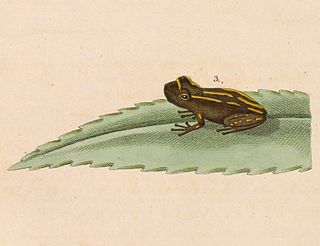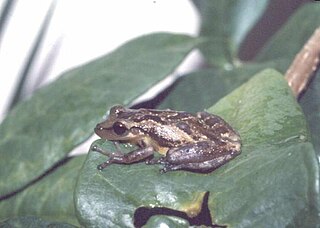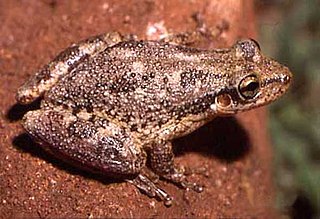
The African common toad or guttural toad is a species of toad in the family Bufonidae. It is found in Angola, Botswana, Democratic Republic of the Congo, Kenya, Lesotho, Malawi, Mauritius, Mozambique, Namibia, Réunion, Somalia, South Africa, Ethiopia, Eswatini, Tanzania, Zambia, and Zimbabwe. Its natural habitats are subtropical or tropical dry forest, subtropical or tropical moist lowland forest, subtropical or tropical moist montane forest, dry savanna, moist savanna, temperate shrubland, subtropical or tropical dry shrubland, subtropical or tropical moist shrubland, subtropical or tropical dry lowland grassland, subtropical or tropical seasonally wet or flooded lowland grassland, subtropical or tropical high-altitude grassland, intermittent rivers, freshwater lakes, intermittent freshwater lakes, freshwater marshes, intermittent freshwater marshes, arable land, pastureland, rural gardens, urban areas, heavily degraded former forest, ponds, and canals and ditches.

Scinax acuminatus is a species of frog in the family Hylidae. It is found in Argentina, Bolivia, Brazil, Paraguay, and possibly Uruguay. Its natural habitats are moist savanna, subtropical or tropical moist shrubland, subtropical or tropical seasonally wet or flooded lowland grassland, freshwater lakes, intermittent freshwater lakes, freshwater marshes, intermittent freshwater marshes, pastureland, rural gardens, heavily degraded former forest, ponds, and canals and ditches. It breeds in bodies of water. It is threatened by eventual habitat loss, but the population is currently fairly stable, as it adapts fairly well to human encroachment and development.

Scinax alter, the Crubixa snouted treefrog, is a species of frog in the family Hylidae endemic to Brazil.

Scinax auratus is a species of frog in the family Hylidae. It is endemic to Brazil. Its natural habitats are subtropical or tropical moist lowland forests, subtropical or tropical moist shrubland, freshwater marshes, intermittent freshwater marshes, rocky areas, and heavily degraded former forest. It is threatened by habitat loss.
Scinax caldarum is a species of frog in the family Hylidae. It is endemic to Brazil. Its natural habitats are subtropical or tropical seasonally wet or flooded lowland grassland, subtropical or tropical high-altitude grassland, freshwater marshes, intermittent freshwater marshes, pastureland, rural gardens, ponds, and canals and ditches. It is threatened by habitat loss.

Scinax crospedospilus is a species of frog in the family Hylidae. It is endemic to Brazil. Its natural habitats are subtropical or tropical moist shrubland, subtropical or tropical seasonally wet or flooded lowland grassland, subtropical or tropical high-altitude grassland, freshwater marshes, intermittent freshwater marshes, pastureland, heavily degraded former forest, ponds, and canals and ditches.

Scinax cuspidatus is a species of frog in the family Hylidae. It is endemic to Brazil. Its natural habitats are subtropical or tropical moist lowland forests, subtropical or tropical moist shrubland, subtropical or tropical dry lowland grassland, freshwater marshes, intermittent freshwater marshes, rocky areas, heavily degraded former forest, and ponds. It is threatened by habitat loss.

Scinax eurydice is a species of frog in the family Hylidae. It is endemic to Brazil. Its natural habitats are subtropical or tropical moist lowland forests, subtropical or tropical moist shrubland, subtropical or tropical seasonally wet or flooded lowland grassland, swamps, freshwater lakes, intermittent freshwater lakes, freshwater marshes, intermittent freshwater marshes, heavily degraded former forest, and ponds. It is threatened by habitat loss.

Scinax fuscovarius is a species of frog in the family Hylidae. It is found in Argentina, Bolivia, Brazil, Paraguay, and Uruguay. Its natural habitats are moist savanna, subtropical or tropical moist shrubland, subtropical or tropical high-altitude shrubland, subtropical or tropical dry lowland grassland, subtropical or tropical seasonally wet or flooded lowland grassland, intermittent freshwater lakes, freshwater marshes, intermittent freshwater marshes, pastureland, rural gardens, urban areas, and heavily degraded former forest.

Scinax nasicus is a species of frog in the family Hylidae. It is found in Argentina, Bolivia, Brazil, Paraguay, and Uruguay. Its natural habitats are subtropical or tropical dry forests, moist savanna, temperate shrubland, subtropical or tropical dry shrubland, subtropical or tropical moist shrubland, subtropical or tropical high-altitude shrubland, temperate grassland, subtropical or tropical seasonally wet or flooded lowland grassland, freshwater lakes, intermittent freshwater lakes, freshwater marshes, arable land, pastureland, plantations, rural gardens, heavily degraded former forest, water storage areas, ponds, and canals and ditches.
Scinax pachycrus is a species of frog in the family Hylidae. It is endemic to Brazil. Its natural habitats are dry savanna, subtropical or tropical dry shrubland, subtropical or tropical dry lowland grassland, intermittent freshwater marshes, rocky areas, arable land, pastureland, and ponds. It is threatened by habitat loss.

Julianus pinimus is a species of frog in the family Hylidae. It is endemic to Brazil. Its natural habitats are moist savanna, subtropical or tropical moist shrubland, subtropical or tropical high-altitude shrubland, subtropical or tropical dry lowland grassland, swamps, and intermittent freshwater marshes. It is threatened by habitat loss.

Leptodactylus gracilis is a species of frog in the family Leptodactylidae. It is found in Argentina, Bolivia, Brazil, Paraguay, and Uruguay. Its natural habitats are subtropical or tropical moist shrubland, temperate grassland, subtropical or tropical dry lowland grassland, subtropical or tropical seasonally wet or flooded lowland grassland, intermittent freshwater marshes, pastureland, rural gardens, and urban areas.

Physalaemus biligonigerus is a species of frog in the family Leptodactylidae. It is found in Argentina, Bolivia, Brazil, Paraguay, and Uruguay. Its natural habitats are subtropical or tropical dry forests, temperate shrubland, subtropical or tropical dry shrubland, subtropical or tropical moist shrubland, temperate grassland, subtropical or tropical dry lowland grassland, subtropical or tropical seasonally wet or flooded lowland grassland, freshwater lakes, intermittent freshwater lakes, freshwater marshes, sandy shores, arable land, pastureland, plantations, rural gardens, urban areas, heavily degraded former forest, water storage areas, ponds, irrigated land, seasonally flooded agricultural land, and canals and ditches.
Pleurodema nebulosum is a species of frog in the family Leptodactylidae. It is endemic to Argentina. Its natural habitats are temperate shrubland, subtropical or tropical dry shrubland, temperate grassland, subtropical or tropical dry lowland grassland, subtropical or tropical seasonally wet or flooded lowland grassland, subtropical or tropical high-altitude grassland, intermittent freshwater marshes, arable land, pastureland, ponds, irrigated land, and seasonally flooded agricultural land.
Goldfield's bullfrog, or Wilsmore's frog, is a species of frog in the family Limnodynastidae. It is endemic to Australia. Its natural habitats are temperate shrubland, subtropical or tropical dry shrubland, Mediterranean-type shrubby vegetation, subtropical or tropical dry lowland grassland, intermittent freshwater marshes, hot deserts, and temperate desert.

The Mascarene grass frog, or Mascarene ridged frog, is a species of frog in the family Ptychadenidae. It is found in sub-Saharan Africa, Madagascar, and Mauritius.
Ptychadena porosissima is a species of frog in the family Ptychadenidae. It is found in Angola, Democratic Republic of the Congo, Ethiopia, Kenya, Malawi, Rwanda, South Africa, Eswatini, Tanzania, Uganda, Zambia, Zimbabwe, possibly Burundi, possibly Lesotho, and possibly Mozambique. Its natural habitats are temperate forest, subtropical or tropical moist montane forest, moist savanna, subtropical or tropical moist shrubland, temperate grassland, subtropical or tropical seasonally wet or flooded lowland grassland, subtropical or tropical high-altitude grassland, swamps, intermittent freshwater marshes, pastureland, rural gardens, and heavily degraded former forest.

The long-legged wood frog, also known as Caucasus frog, Brusa frog, or Uludağ frog, is a species of frog in the family Ranidae found in Armenia, Azerbaijan, Georgia, Iran, Russia, Turkey, and Turkmenistan.

The Natal sand frog is a species of frog in the family Pyxicephalidae. It is found in Mozambique, South Africa, and Eswatini, and possibly Botswana, Lesotho, and Zimbabwe. Its natural habitats are dry savanna, moist savanna, subtropical or tropical moist shrubland, temperate grassland, subtropical or tropical dry lowland grassland, subtropical or tropical high-altitude grassland, rivers, intermittent rivers, swamps, freshwater marshes, intermittent freshwater marshes, arable land, pastureland, and ponds.
















